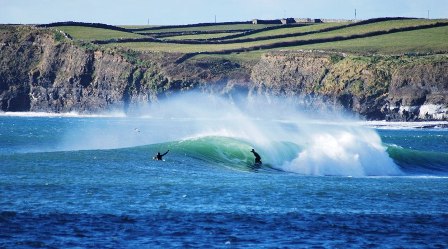The Wild Atlantic Way ~ Day 1
 As I await my tour guide outside of the Park House Hotel on Forster St. in downtown Galway, I speak with three young French, Spanish and Italian cyclists who have come to western Ireland to train for this summer’s Tour de France.
As I await my tour guide outside of the Park House Hotel on Forster St. in downtown Galway, I speak with three young French, Spanish and Italian cyclists who have come to western Ireland to train for this summer’s Tour de France.
Interestingly, though our timelines differ – they are gone a week, while myself just the day – their intended route is identical to mine; down to the The Burren, over to the Cliffs of Moher, up along the coastline through Doolin, Lisdoonvarna, Ballyvaghan and Kinvara, before returning to Galway.
The conditions here are ideal, they tell me; fresh air, hilly climbs, long scenic stretches of road, and an assortment of weather.
My driver, Joe Donoghue, arrives. I ask him about our itinerary for the day. “Fresh air, hilly climbs, long scenic stretches of road, and an assortment of weather.”

South Bound
Minutes south of the city, grey gives way to green as rich and plush countryside fills the gaps between the quaint communities of Oranmore, Clarinbridge and Kilcolgan.
Herds of tour buses rumble along tiny two-lane roads, stopping only to allow travelers time to soak in the gorgeous landscapes and gentlemen’s farms.
“Tourism is our number one industry in Ireland,” shares Donaghue, whose own company picked up the country’s Coach Tour Company of the Year Award in 2014. “All this traffic is great for these communities.”
Indeed, centuries-old villages are popular stops, with many pubs open early for visitors looking to prop-up the day with a fresh pint. The townspeople simply smile when asked to pose for photos, sometimes answering questions about local family names and lore. And western Ireland has more than its fair share of lore and legend; the land and the people here are one, forever enmeshed in myth and mystique.

The Burren
An hour down from Galway, over the border into County Clare, sits The Burren. Taken from the Irish ‘Bioreann’, meaning rocky place, the 100 square-miles of weathered landscape has inspired poets, painters, photographers, and artists of all disciplines for hundreds of years.
“It isn’t good for much else,” laughs Donaghue, adding that the rugged terrain is void of usable topsoil. “A man can own 300 acres of land here, and the only thing of any value will be his house.”
Sure enough, aside from the grazing of some livestock, there is little or no activity on any of the homesteads we pass. However, the area is ripe for outdoor enthusiasts, with a number of good walking trails open almost year round, as well as excellent hiking opportunities across the rollicking hills. A nearby Geo Park is also a solid option for those seeking greater detail on the area’s unique ecosystems. Thankfully, due to its status as a National Park, the region’s raw physical beauty will remain unspoiled for generations.
 Seaside
Seaside
West of The Burren, by the beaches of Lahinch, an array of adventure awaits; surfing, swimming, sailing, sea kayaking, deep sea fishing, and dolphin watching are just a few of the exhilerating outdoor activities available to both locals and visitors.
“The water can be a wee bit cold,” admits Donoghue, “but that doesn’t stop anyone from enjoying themselves.”
Even in mid-March, the craggy coastline is packed with beach goers and ocean lovers looking to bathe themselves in sun, sand and surf. “It’s quite refreshing, actually,” he adds, pointing out a multitude of colourful cottages and summer homes close by. “The hard part is getting into the water, taking that first step. Once you’re in, you’re in, and you’ll be fine.”
Nearby in Liscannor, a small fishing vessel comes in from a morning run. A boatload of American sportsmen returns with a well-measured haul of shark, pollack, ling, ray, and mackerel. Cameras come out, and pictures, along with bragging rights, are posted to Facebook for the folks back home.

The Cliffs of Moher
Ireland’s most popular outdoor attraction is also a mosaic of culture. With over 1 million visitors annually, accents are in abundance; Irish, American, Canadian, and Australian of course, but also German, Japanese, Brazilian, Senegalese, Israeli and more.
“It’s sort of a United Nations without the politics,” cracks Donaghue, always quick with the wit, “or a Mecca without the religion.”
My guide is only half-kidding; today, with unusually warm weather and clear skies, busloads of young and old climb the bluff. Atop the summit, against a breathtaking backdrop of sheer rock, spindrift and swirling gulls, couples, friends and families pose for selfies.
The immensity of the 8 kilometer panorama is almost indescribable. The salt air is cool with a gentle mist, the deep blue and green of the sea seems to go on forever, with the visage of the three Aran Islands – Inisheer, Inishmaan and Inishmore – just visible to the naked eye upon the horizon. The main attraction, of course, is the cliffs themselves; majestic, grand and glorious. A few meters up, just past the stately O’Brien’s Castle, hundreds of hikers hug the precipice along the Burren Way, a coastal walking trail that offers up awe-inspiring views from different directions. And all the while, there is the eternal crashing of waves against the shore, both sensational and soothing at once.
The mandatory exhibit center and gift shops do brisk business, with visitors lining up to take a piece of the experience home with them. Donaghue and I are content with coffee, however, happy for the fresh air, hilly climbs, long scenic stretches of road, and an assortment of weather ahead of us as we head back to Galway. ~ Stephen Patrick Clare



















Leave a Comment